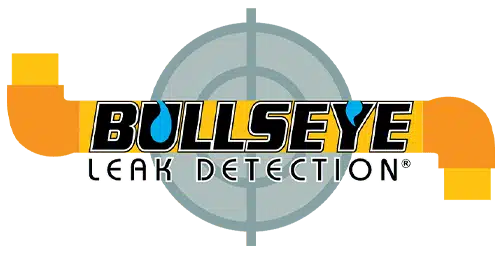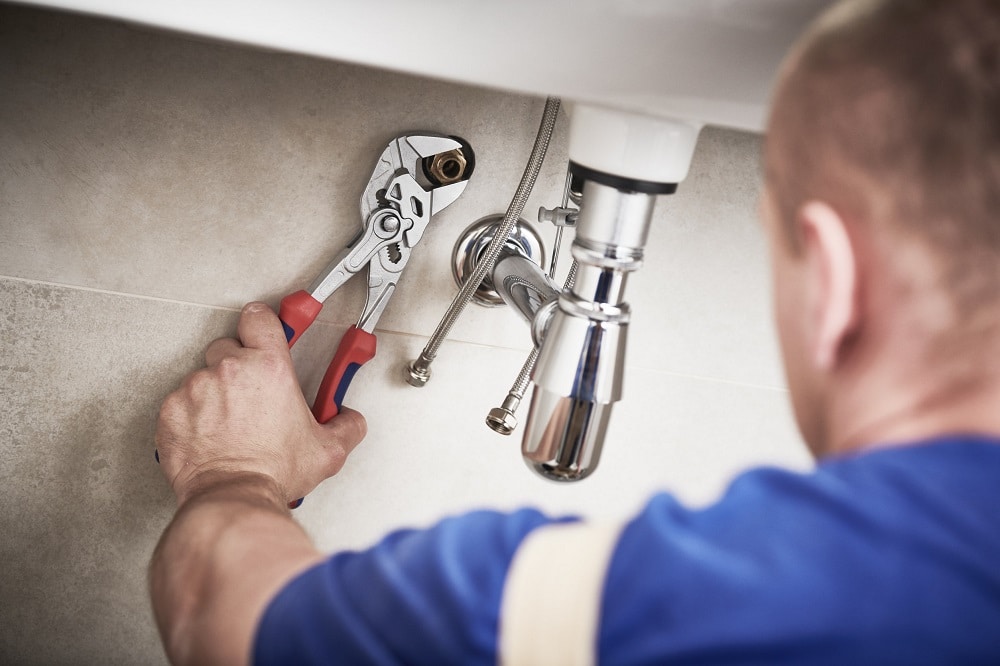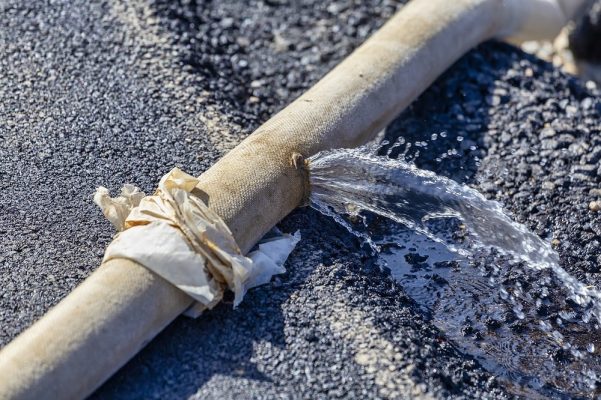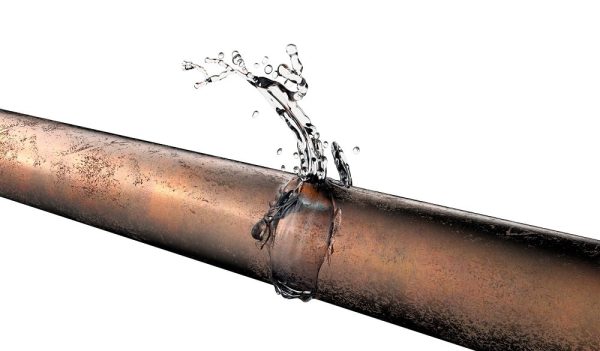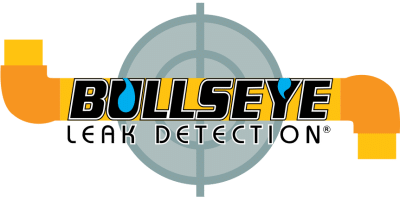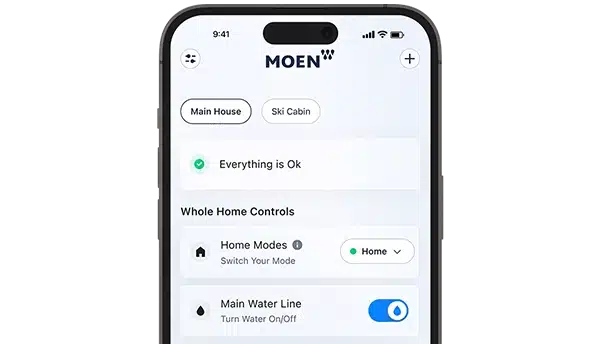Stray moisture can cause thousands of dollars of damage in your home. Water leaks from plumbing and appliances can be hard to spot until it’s too late, so here are the top four signs that you have hidden water leaks in your home.
Hidden Water Leak Signs
Mold
One of the most serious dangers of water leaks, mold can deteriorate some of the most valuable building materials in your home, including wood, drywall, and carpet. Look for brown, black, blue, or green spots. Mold needs water to live, so if you see mold, there’s excess moisture.
Wet Spots
Do you see puddles around some of your appliances, like your bathtub, toilet, or dishwasher? These are clear signs that water is leaking out of the seals or joints. A plumber will need to investigate the source of the stray water.
Odor
A musty, moldy odor is a clear sign that there is water damage somewhere in your home. Follow the scent to identify the area where the leak may be taking place. If you don’t see water, the leak may be under the flooring or inside your walls.
High Water Bills
Are your utility costs suddenly much higher? If so, then you may be losing more water than usual. Even a slight drip can waste several gallons of water in a day, so you may have a serious leak if your water bill spikes for no apparent reason.
If you spot any of these signs of a water leak, call Bullseye Leak Detection, Inc. We serve Sacramento, CA, area homes with fast and courteous service. We offer a wide array of plumbing services to homeowners like you, including leak detection, plumbing repairs, pool services, and more. We understand that your time and money are precious, and that’s why we proudly offer efficient services at great prices. Visit https://www.bullseyeleak.com/ or call (916) 760-8944 today to learn more about protecting your home from expensive water damage, or to schedule any of our services today.
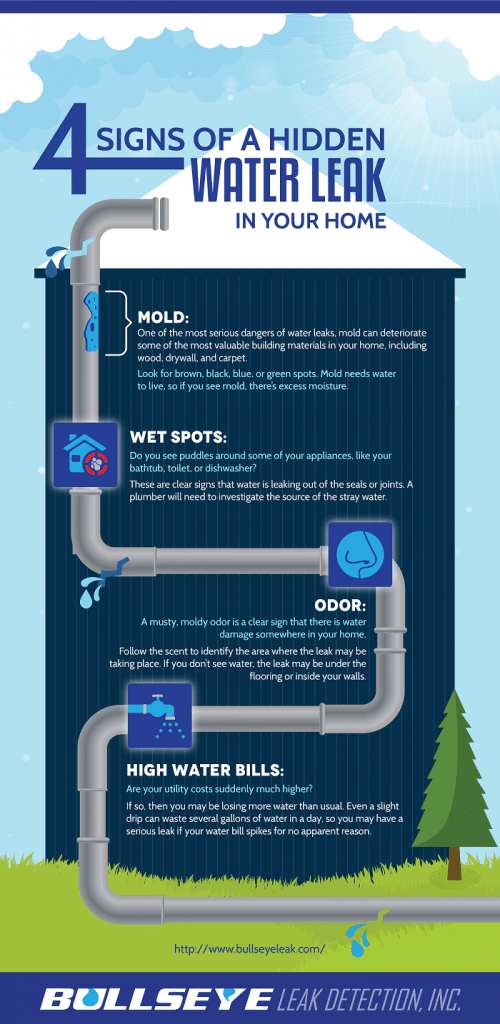
Methods to Detect Water Leaks in Your Walls
You might think a leak is always obvious, but you’d be wrong. Much of your plumbing is sealed inside your walls, and when one of these pipes leaks, it can continue leaking for weeks or even months before it’s noticed. This infographic outlines the most common methods for detecting and locating a water leak that’s inside your walls.
Visible water damage
If a water leak goes untreated for a while, you’ll begin to develop visible signs of water damage on your walls. This includes bubbling and peeling paint, discoloration on the walls, and soft, spongy drywall. Ideally, you should catch the problem before it reaches this point of damage, but that’s not always possible.
Noticeable musty smells
Another simple method of leak detection is your nose. Where there’s moisture, there’s likely mold and mildew growth. Again, it’s best if you catch these leaks before mold begins to grow, but hidden leaks can be tricky. If you notice a musty smell in a specific area of your home, it’s time to start looking for a leak.
Moisture detectors
In terms of leak-detecting tools, moisture detectors are among the most common. These devices are highly sensitive to increased levels of moisture in materials. If placed in an area with a hidden leak behind it, the device will emit a loud beeping sound to indicate the presence of high moisture levels and will give you a good idea of where the leak is located.
Ultrasonic devices
Even if you can’t hear it, a leaking pipe will always make a noise. Professional leak detectors use ultrasonic listening devices to pick up on the tiny sounds of dripping or spraying water, which are muffled by your walls.
Infrared cameras
Another tool often used by leak detection experts is an infrared camera. Leaky pipes create obvious cold spots inside your walls, making it easy to find the leak with this tool.
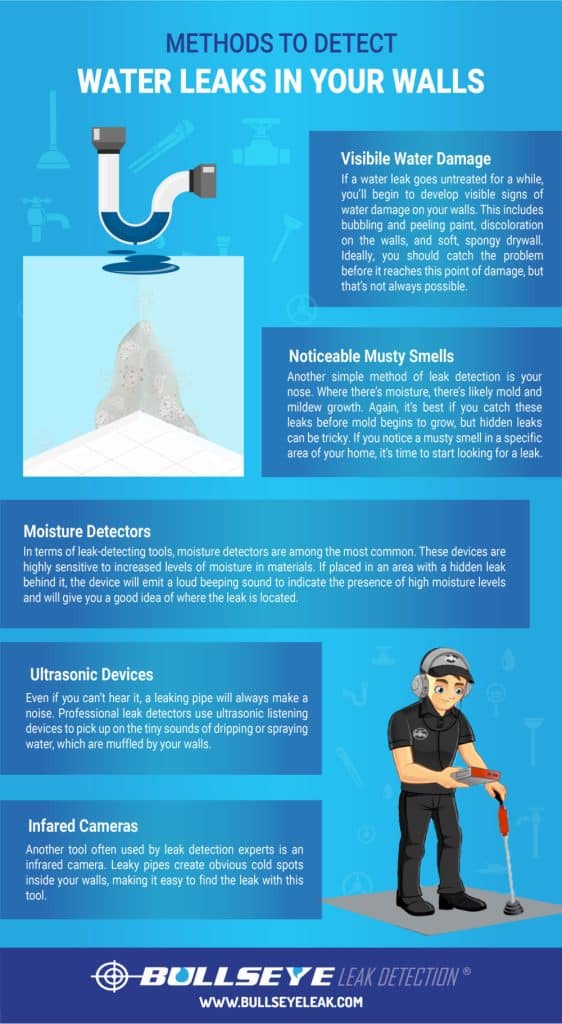
5 Ways to Find Hidden Water Leaks
The Value of Early Detection
Water leaks have the potential to be devastating, both in terms of cost and damage. Even small, slow leaks can create major problems. Leaking water gets everywhere; it seeps under floors, wicks up walls, soaks furniture, and saturates carpets and pads. When allowed to sit, it will rot wood, ruin drywall, weaken structures, and create the perfect environment for mold and mildew to grow.
Early leak detection in plumbing in Sacramento is key to preventing significant damage. Being aware of the most common signs of water leaks and employing a generous dose of common sense can protect you from big water problems.https://www.bullseyeleak.com/
Some leaks are obvious; you can hear or see dripping faucets and running toilets. But other leaks are more insidious, stealthily creeping into the corners of your home and hiding until it’s too late to prevent the damage. Much of your water piping is hidden in walls and underground, making it difficult to sense the presence of a leak. Be aware of the following five ways to find hidden water leaks:
Your water usage has increased.
Keep a close eye on your family’s monthly water usage; it should stay pretty consistent over time. If you can’t explain significant increases – houseguests, yard watering, pool filling, etc— a big increase in your water bill could be a sign of a hidden water leak.
Your meter is running.
If you suspect a leak, you can do a quick water meter test. Ensure there’s no water running in your home, and then step outside to look at your water meter. The water meter measures the water flowing through your home; if it’s moving, you’re using water somewhere. If you’ve turned everything off and you can see the meter moving, you’ve got a leak somewhere. You might need to keep all the water off for a few hours and check the meter several times to detect signs of a slow leak.
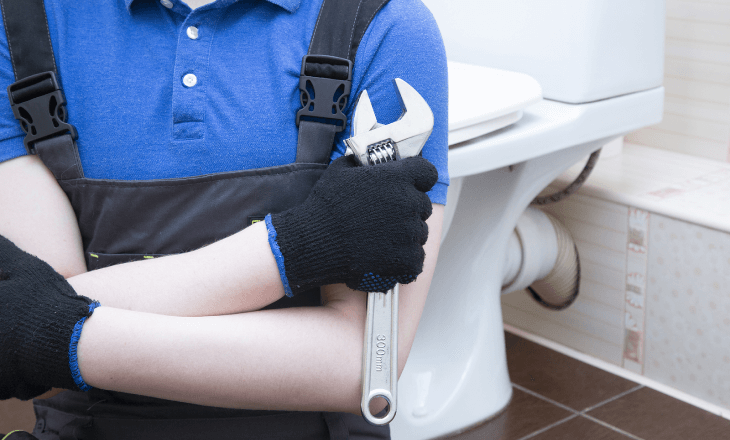
Your toilets are running.
Toilets consume a lot of water; some estimates put them at a whopping 30% of the total water usage in a typical home. A running toilet can fill a septic tank in a matter of hours. If your water usage has increased or you’ve seen movement on your water meter, the first places to check for leaks should be the toilets. Some toilet leaks you can hear, but many are very quiet. Water slowly seeps through gaps and low seals in the tank mechanisms into the bowl in a toilet leak. You can check for a leak by dropping a few drops of food coloring into your toilet tank. Wait about 10 minutes and then check the bowl; if you see color, you know water from the tank has been leaking into the bowl.
Your house has a musty smell.
Mold and mildew are sure signs of unwanted moisture, and they bring an unpleasant, musty odor with them. If your nose notices something unusual, it’s time to look for a hidden water leak. Regularly looking under sinks and in cabinets that hold plumbing pipes will alert you early to any signs of water leakage.
Your yard is soggy.
Leaks don’t just happen inside; you’ve got lots of water pipes outside your home as well. External faucets, underground piping, and irrigation systems carry hundreds of gallons of water. If you notice otherwise inexplicable soggy areas in your yard, one of these outdoor underground pipes may be leaking.
Reasons for a High Water Bill
Nobody likes to get a high utility bill. Sometimes, you expect a spike in that monthly expense. In the heat of the summer, you know you’re going to turn up the AC. In the dead of winter, your heating bill goes up. But if your water bill has spiked and you’re not sure of the cause, that may be a sign of a water leak.
Leaking Toilets
Toilets are a significant water user in your home, accounting for roughly 31% of indoor water usage in the average American home. If that toilet is leaking, it can add hundreds of dollars to your water bill over the months.
Most people recognize a leaky toilet because of how often it runs. If it sounds like your toilet bowl is constantly refilling, you need to start searching for the leak even if you haven’t used it recently. Check the tank flapper, seals, and water line connections to see if you can locate the problem. In most cases, the issue is a faulty flapper, which can be fixed with just a few minutes and a couple of dollars for the correct part.
Leaking Faucets
That steady dripping from your sink isn’t just irritating—it’s wasteful. Check all your faucets and fixtures to locate leaks in these areas. Most faucet leaks are caused by a faulty rubber washer, which is another straightforward and inexpensive fix. It’s much better to spend an afternoon fixing those minor leaks than to continue wasting gallons of water a day!
Main Line Leaks
Unlike the other leaks we’ve discussed, this kind of leak isn’t something you can fix with a trip to a hardware store. Simply locating the leak takes specialized equipment, and digging up and replacing the leaky water main takes an expert to avoid disastrous consequences. If your water bill is high and you’ve noticed unexplainable puddles on your property, a mainline leak may be to blame, and you should contact us right away.
Changes in Water Consumption
If you don’t notice any leaks anywhere in your home, you should carefully consider any recent water consumption changes in your home. Many different factors can cause water bills to spike. Ask yourself the following kinds of questions:
- Did you install new, water-consuming equipment?
- Did you put in new landscaping that required extra watering?
- Have you had to water your lawn more over the last month than usual due to hotter or drier weather?
- Did you have guests staying in your home over the last month?
All of these are common contributors to a sudden spike in your water bill. If you answered yes to any of the questions above, it could be the reason your water consumption increased last month.
Of course, it’s always a good idea to examine your water consumption for bad habits that wastewater. Running your washing machine or dishwasher when they’re half empty, overwatering your lawn, and taking unnecessarily long showers are all everyday habits that waste a significant amount of water. No matter what your bill was, consider ways you can cut down on your water usage.
If you do suspect a leak, but you can’t find where it’s located, contact Bullseye Leak Detection. We’re an experienced and reliable water leak detection company, and we can find and fix your leak quickly. Give us a call today.
How Does a Plumber Detect Hidden Leaks?
Sometimes, a leak is easy to spot. You might hear it dripping when your house is quiet, feel the moisture in the cabinet under your sink, or even see the water slowly dripping from a pipe or plumbing fixture. But other leaks are much more difficult to find. Even if you know something is leaking, the exact source of the leak can be hidden in your walls and even underground. How can a plumber find and repair these kinds of leaks? At Bullseye Leak Detection, we use some of the best plumbers in Sacramento and the most advanced leak detection technology to get the job done. Keep reading to learn more about some of our tools and techniques.
Visual Inspection First
We’ll always perform a visual inspection of your home first to help us get a general idea of where leaks may be occurring. This can include searching for higher humidity in certain areas of the home, watermarks on paint, or even especially lush areas of your lawn. All of this helps to give us a starting place when pinpointing the exact location of any leak (or leaks) on your property.
Soil Probes
If we suspect a leak in any outdoor plumbing lines on your property—namely, your sewer line and water main—we may use a soil probe to help us find where the pipe is leaking. A soil probe allows our team to listen for any leaks, even through the grass, dirt, and rocks. This advanced audio equipment allows us to detect the noises made by both standard pressure and pressured leaks. As the equipment moves along the affected pipe, the noises will get louder until we can pinpoint the exact location of the leak. Our experienced plumbers can identify the type of leak, how deep underground it is, and the best way to access the pipe and repair it.
Thermal Imaging
Even if you can’t see a leak with your eyes, you may be able to see the way it affects the temperature of things around it. The water in your supply lines is cold—very cold—so when it leaks out, it drops the temperature of everything it touches. If you have a leak hidden in your walls or underground, we can often use thermal imaging equipment to find these cold spots created by leaking water. This type of equipment is much more adept at detecting hidden leaks and can even detect moisture that would likely go undetected when using moisture meters. Through the use of thermal imaging equipment, we can find the source of the leak and get an idea of how the water has damaged much space around it.
Listening Discs
Listening discs are a relatively basic form of auditory leak detection, but that doesn’t make them any less useful. Just as a doctor uses a stethoscope to amplify the sounds of your heart, listening discs amplify the sounds of leaking water into a pair of headphones worn by a plumber. We simply place the disc against the wall and move it along the surface until we pick up the sounds of a leak. With this equipment, we can find leaks behind your walls long before there are water stains on your drywall.
Video Inspection Equipment
Often, we may know the exact pipe leaking, but not exactly where the leak is along the length of the pipe. For these cases, we may rely on video inspection equipment to get an up-close look at your pipe’s interior. We’ll insert a tiny video camera into one end of the pipe, which will transmit a live feed to a screen. We’ll thread the camera along the pipe’s length until we find the source of the leak. We can examine it closely to determine the extent of the damage even before we begin to excavate the area for repairs or pipe replacement.
Experience Matters
Our plumbers are among the best in the industry and can pinpoint and repair leaks quickly and efficiently. We always thoroughly inspect our repairs and pipe replacements and perform a pressure test to ensure that our work is done and that no leaks have gone unnoticed. While we rely on these tools to help us become more efficient at detecting leaks on your property, nothing can replace knowledge and experience.
If you have any reason to believe that there’s a leak in your plumbing, contact the plumbing experts at Bullseye Leak Detection today. Our team of knowledgeable experts will come out to your property and inspect your plumbing using our advanced technology so we can find that leak quickly, get it repaired, and prevent any further water damage from occurring in your home.
